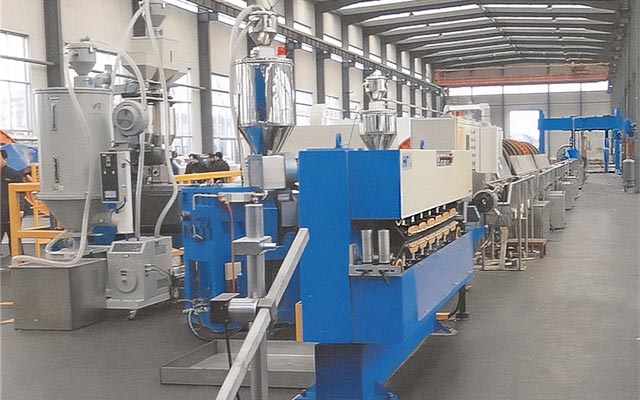Model 70-120Screw Diameter φ70-120L/D Ratio 26:1/25:1Extrusion Output 140-450 kg/hMain Motor 40-165 KWOutlet Diameter 2-80 mmSpeed 80-300Application YJV low-voltage power cable
YJV Power Cable Extrusion Line
The full name of YJV cable is Copper Core XLPE Insulated PVC Sheathed Power Cable. YJV cable is currently the most mainstream and widely used medium and low voltage power cable on the market.
Meaning of the lettersYJ: Represents the insulation material, which is cross-linked polyethylene (XLPE). This is its core feature.
V: Represents the sheath material, which is polyvinyl chloride (PVC).
The omitted "T": In the model designation, the copper conductor (T) is usually omitted, so YJV defaults to a copper core. The aluminum core model is YJLV.
Rated voltage: Commonly used at 0.6/1kV, with higher voltage levels such as 8.7/15kV also available.
Operating temperatureLong-term allowable operating temperature: ≤90℃ (a significant advantage over VV cables' 70℃).
Short-circuit temperature (max. 5s duration): ≤250℃.
Main characteristicsAdvantages:
Excellent heat resistance: The 90℃ long-term operating temperature allows its current-carrying capacity (the current that can be carried for the same cross-section) to be much higher than that of VV cables (approximately 30% higher). This means that for the same power requirements, a smaller cross-section YJV cable can be selected, saving costs and installation space.
Outstanding electrical performance: XLPE insulation offers high insulation resistance, low dielectric loss, and good corrosion resistance.
Good mechanical strength: The insulation layer is wear-resistant, crush-resistant, and has strong anti-aging capabilities, ensuring a longer service life.
Easy installation: Compared to VV cables, YJV cables have a smaller bending radius, are lighter in weight, and are easier to install.
Disadvantages:
Contains halogens: The sheath material is PVC, which, when burned, releases black smoke and toxic halogenated gases. This is its main drawback. Therefore, its use is restricted in densely populated areas and must be replaced with halogen-free low-smoke cables.
YJV Power Cable Extrusion Line
The YJV low-voltage power cable extrusion production line is a complete set of equipment specifically designed for manufacturing insulated cores and protective sheaths of power cables rated at 0.6/1 kV and below. Its core process involves melting solid plastics (such as PVC or XLPE) through heating and pressurization, then continuously and uniformly coating conductors (copper/aluminum wires) or assembled cable cores. After cooling and solidification, a smooth, dense, and uniformly thick insulating layer or protective sheath is formed.
Core Components
The YJV power cable extrusion production line is a highly coordinated automated system, primarily consisting of the following major components:
Pay-off Unit:Supports and releases the conductor or cable core, providing stable and controllable tension to prevent thinning or twisting of the conductor.
Preheater:Heats the conductor before it enters the die head to remove moisture, reduce internal stress, and improve adhesion between the plastic and the conductor.
Extruder:Screw: Conveys, compacts, melts, and homogenizes the plastic.
Barrel: Heats and cools the plastic.
Drive Motor: Provides power to the screw.
Die Head: Connects the extruder to the die.
Die (Tip and Die): Determines the thickness, concentricity, and shape of the extruded layer.
Cooling Trough:Rapidly cools and solidifies the high-temperature cable. Typically features segmented temperature control to ensure material stability and avoid internal stress.
Haul-off Unit:Provides the driving force for the production line. Its speed must be extremely stable, as it is critical for ensuring uniform extrusion thickness.
Spark Tester:An online quality inspection device that applies high voltage to the insulating layer to detect defects such as pinholes or impurities, triggering alarms and marking the locations.
Take-up Unit:Winds the finished cable neatly onto a reel, maintaining constant tension and synchronizing with the haul-off speed.
Control System:Uses a PLC / industrial computer to centrally control all parameters (temperature, speed, tension, etc.), ensuring stable and reproducible production.
YJV Power Cable Extrusion Line Datasheet
| Model |
70 |
80 |
90 |
100 |
120 |
| Screw Diameter (mm) |
φ70 |
φ80 |
φ90 |
φ100 |
φ120 |
| Screw L/D Ratio |
26:1 |
26:1 |
26:1 |
25:1 |
25:1 |
| Extrusion Amount (kg/hr) |
140 |
200 |
250 |
320 |
450 |
| Outlet Wire (mm) |
2-15 |
3-25 |
5-35 |
8-60 |
10-80 |
| Total Power (KW) |
40 |
55 |
63 |
120 |
165 |
| Production Speed(Max., m/min) |
300 |
200 |
200 |
100 |
80 |
| Take-up Spool |
500/800 |
800/1250 |
800/1600 |
1000/2000 |
2000/2500 |
| Storage Length |
240 m |
200 m |
180 m |
0 |
0 |
YJV Power Cable Extrusion Line Application
The YJV low-voltage power cable extrusion production line is a complete set of equipment specifically designed for producing YJV cables & other insulation cores and sheaths of power cables with rated voltage of 0.6/1kV and below. The details are as follows:
Conductor Insulation
Function: Extrudes insulating material onto copper or aluminum conductors to form the primary insulation layer.
Common Materials: Cross-linked polyethylene (XLPE), polyethylene (PE), polyvinyl chloride (PVC), etc.
Requirements: Uniform thickness, high concentricity, absence of impurities, and no microvoids. The insulation extrusion process for high-voltage cables demands the highest technical precision.
Sheathing Extrusion
Function: Extrudes a protective sheath over the assembled cable core.
Purpose: Provides mechanical protection, corrosion resistance, moisture resistance, UV resistance, flame retardancy, etc.
Common Materials: Polyvinyl chloride (PVC), polyethylene (PE), polyolefins, etc.


